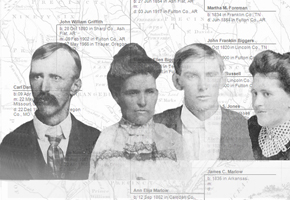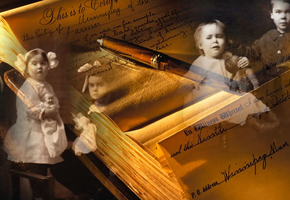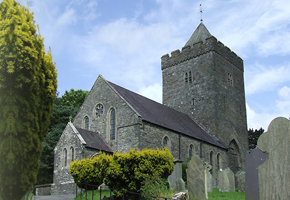Frequently Asked Questions
- What is Y-DNA and how does it apply to genealogy?
- Where can I find more information on DNA studies?
- Why can't DNA from women be used for this project?
- How do I join the project?
- How long does it take to get results from a test?
- What is Genetic Distance?
- What are the columns in the Results Table labeled GD Mode and GD/Mrks?
- Is there a common ancestor in Wales or England for the Griffith/Griffin/Griffis surname?
What is Y-DNA and how does it apply to genealogy ?
DNA is the basic building block for all life on Earth. In humans, DNA is organized in long, twisted strands of molecules. These strands are further combined into "packages" called chromosomes. Each human has 23 pairs of chromosomes. Half of each chromosome pair is derived from the individual's mother, the other half from the father. The 23rd chromosome pair is the one that determines the person's gender. In males, this pair consists of one "X" chromosome and one "Y" chromosome. Females have two "X" chromosomes. The Y chromosome is passed virtually unchanged from a father to his sons. Consequently, two males living today that share a common male ancestor could be expected to have identical Y chromosomes.
The Y-DNA used for this project is based on a series of "junk" DNA sequences present on the Y chromosome. These sequences do not contain critical information needed by the human body and none of the information can be used to identify a specific individual. Testing of this portion of the Y chromosome provides information about the direct male line—father to father to father and so forth back through time.
The locations tested on the Y chromosome are called Markers. Occasionally a mutation occurs at one of the Markers in the Y chromosome. A mutation is simply a small change in the way the molecules are assembled. These occasional mutations, which are estimated to occur about once every 500 generations per Marker, form the statistical basis for y-DNA genealogical studies.
If you have further questions, email the project administrator at admin@dna.rdgriffith.com.
Where can I find more information on DNA studies?
Why can't DNA from women be used for this project?
The set of markers used for this type of study are taken from the Y-Chromosome, which is only passed from a father to his sons. Daughters receive two X-Chromosomes, so the markers are not present in the DNA sample from a female.
How do I join the project?
This project is intended for individuals with a direct paternal lineage to a Griffith(s), Griffin, Griffis ancestor. To join the project, please complete the DNA kit order form at the following link.
If you have problems accessing the on-line form, contact the administrator at admin@dna.rdgriffith.com, or call 309-694-3569.
How long does it take to get results from a test ?
The average time for lab procedures is about 6 weeks. Actual dates may vary
due to the number of kits in your batch, as well as the need to re-run the
sample.
If you have ordered an extended Y-DNA test you’ll most likely receive the first
12 markers back followed in a few days by the next set of 13 markers. Quality
Control is very strict about 2 sets of eyes confirming every score. This takes a
little longer, but it also dramatically reduces the chance that an incorrect
score is reported!
If more than a week went by from the targeted date without your results being
posted, it means that most probably we did not get a result on the first pass
during the sequencing process. From our lab's experience this happens in about
10 - 15% of the times. This can be caused by a number of factors, such as a poor
scrape, or a marker may produce a "dual peak" where a single peak is expected.
In all of these cases we will re-run the entire sequence from the same DNA that
was extracted from vial A. This will produce a complete new set of scores for
your sample. The two sets are compared, and the geneticist makes a
determination. If once again the results are incomplete we then extract the DNA
from vial B and start the above process again.
The lack of results after this series of attempts (2 from vial A and 2 from vial
B) will prompt us to send you a new kit (free of charge) for a new scraping, as
the initial samples didn't give the lab enough quality DNA to work from.
Although this adds to the delivery time, it ensures that we report accurate
results, so please bear with us as in the final analysis accuracy is far more
important than speed.
What is Genetic Distance?
Genetic distance is a term used to describe the degree of mismatch between two Y-DNA test results. In general, the greater the genetic distance between two DNA samples, the further you must go back in time to find a common ancestor.
While genetic distance can be a useful way to evaluate the likelihood of relatedness, it should not be considered "proof" of relatedness. The science of genetics is still evolving and there are several different methods currently being used to calculate genetic distance. The calculation algorithm used for this project produces similar results as the one used by the FTDNA Genetic Distance Report.
Click here for more information on how to interpret Genetic Distance.
What are the columns in the Results Table labeled GD Mode and GD/Mrks ?
A "Mode" value is calculated for each haplogroup in our project. This calculation finds the most commonly-occurring values for each marker. The GD Mode column contains the calculated genetic distance of each record to the mode value. Since genetic distance is meaningful only within the context of the number of markers compared, the GD/Mrks column contains the genetic distance divided by the number of markers tested for each record. This provides a resolution-independent approximation of genetic distance from the Mode value and is used to sort the records.
The mode value in and of itself in not particularly meaningful. As a general rule, a participant closer to mode value is more likely to find a match within the group than a participant further away from mode value.
Is there a common ancestor in Wales or England for the Griffith/Griffin/Griffis surname?
It is apparent that there is no single (or even a few) common ancestors for
the name Griffith/Griffin/etc. in Wales or elsewhere. The reason is
straightforward: Griffith is a common first/given name in Wales. When England
forced a change from the patronymic naming system used in Wales prior to the
16th century, the common practice was to simply adopt the given name of the
father or other ancestor. Consequently, John ap Griffith (John, son of Griffith)
became John Griffith. Let's say that Griffith had a brother named Howell and
Howell had a son named Rhys (known as Rhys ap Howell). Rhys would probably have
adopted the name Rhys Howell. So two first cousins, John Griffith and Rhys
Howell share a common paternal ancestor.
Since Griffith was so common a given name, there are literally thousands of
Griffith families today who are totally unrelated paternally. That being said,
we are now beginning to see several groupings of Griffith and Griffin
participants in our DNA project who do share a common paternal ancestry.





